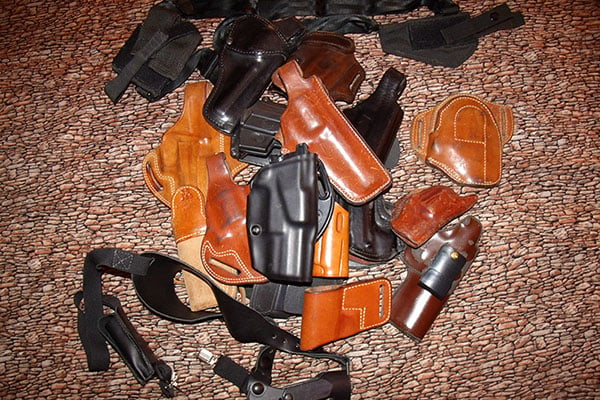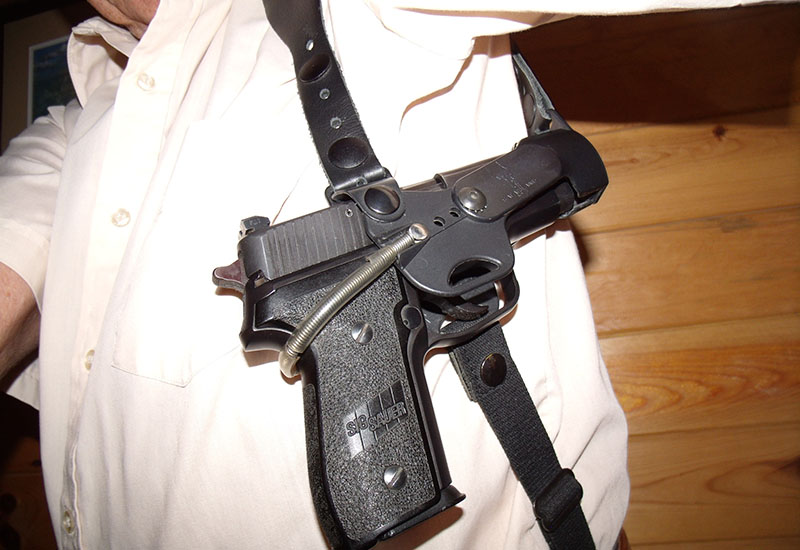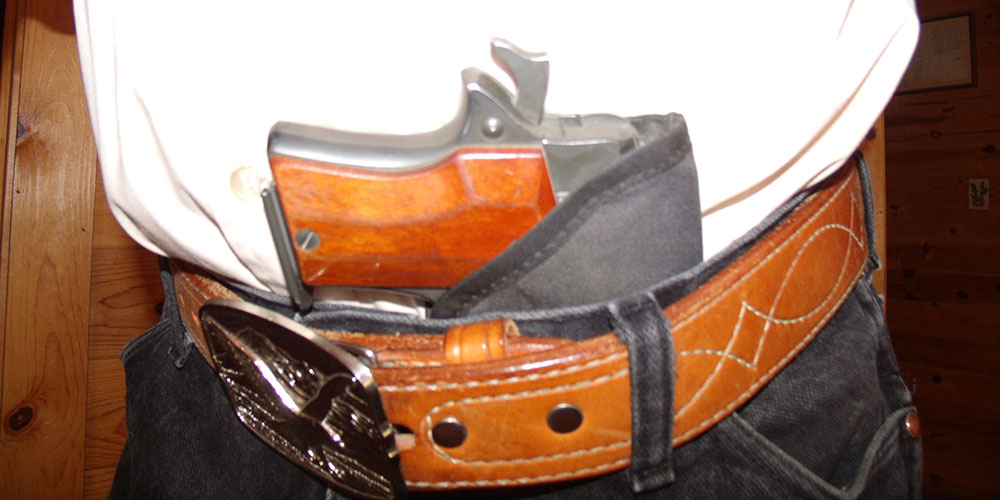
Last Updated on
One of the more frequent questions I get about concealed carry is “where is the best place to carry my handgun?” Since we all come in different shapes, the answer is somewhat unique to each person. Line up a dozen folks, all 6’ and 200 pounds, and you are likely to have a dozen different body shapes, fat percentages, etc. Other factors are where you live, where you work, and how you dress. But there are some basic considerations of location on our bodies for our defensive tools.
I started carrying handguns concealed at age 18, in accordance with the laws of the state I lived in at that time. Now, 50+ years later, I have carried a concealed handgun virtually every day as a civilian, Federal Agent, and a civilian again. Along the way I tried about every method possible, and accumulated several LARGE boxes of quality holsters that just did not work for me. Changes in fashion have also affected where guns get carried – does anyone remember “Leisure Suits” or “Nehru Jackets?“ I have carried revolvers and semi-automatics, large and small. So read on and lean from my experience, and avoid some of my mistakes.

Base Issues
One issue to be considered is gun retention – will the holster hold the gun in place while I run, bend over, jump in and out of high 4 wheel drive trucks, and even if I fall? It would be a bad thing to stumble in the mall and have your expensive sidearm go sliding across the floor, scaring the sheeple. You would be sure to have an interview with those fine local government employees who all dress alike, and drive those cars with lights on the roof!
I use holsters either in leather, closely formed to the gun, or kydex (polymer) with adjustable tension screws, or those with a finger release, either a thumb break or index finger. This is why those inexpensive (can we say cheap) one size fits most holsters of soft nylon are not recommended! Why spend hundreds of dollars on a gun, and then put it into the least expensive holster you can find? Are you really betting you can save your life drawing from a $15 soft holster? I wish you luck!!
In the same sphere, why spend good money on a gun and quality holster, to then put it all on a “El Cheapo” belt. I once had a good belt with a so-so buckle. As I stepped out of the car at a major match, the buckle broke! Irreparably! For some reason (luck, not foresight), I had thrown another buckle into the bottom of my gun bag, which saved the day.
Retention for openly worn guns is more of a problem, which is why police service holsters have levels of retention, usually numbered 1, 2, and 3. If you decide to carry openly, you should only consider these types of holsters, at level 2 or 3. I have read recently of someone carrying openly who had his pistol stolen right out of his holster.
There are several types of holster materials. They range from very soft, to firm and hard. The very soft are usually for pocket or inside the waistband use, and are usually made of nylon. They usually have some sort of “grippy” material on the outside of the holster, so the holster stays put as you draw your gun. The firm also go inside the waistband, but can be nylon, leather, or thin kydex. Belt holsters are usually leather or kydex, although some open carry holsters are made of stiffened nylon. The stiffer the holster, the easier it is to reholster – you really do not want to greet the local police after a necessary use of force with a gun in your hand! Some leather “inside” holsters have a band of thick leather or polymer to hold the holster open after your draw. If you are using a soft holster, I strongly suggest you place the gun in the holster before placing the holster on your person. If part of the holster gets inside the trigger guard, there may be an unwanted sudden LOUD bang!
There are also paddle holsters, for those who need to frequently remove and replace their gun, so it is easier to remove the gun and holster as a unit. Back when I started, the paddle was just a flat piece, which sometimes meant that at the worst possible time, when you needed your gun, you got the gun – and the holster. Yes, it happened to me, fortunately only in a match, not on the street. One more holster for a yard sale to someone I did not like!
Modern paddle holsters have solved this problem, either with grippy material on the paddle, or, more commonly, with a tooth on the paddle that holds onto the bottom of your belt. The down side (at least for me) is that the paddle holsters are harder to remove than a belt holster – I don’t want to have to partially undress just to take the holster off!

Body Shape Matters
Lets us start by visualizing our bodies as if they had been sectioned horizontally at the waistline, and we are looking down from above. Most of us would describe an oval, thicker in the middle, thinner on the ends. Others approach a perfect circle, while a few are nearly flat in front and back – say, a very thin oval. And over time, our shape changes. I weigh about the same as when I graduated High School, but my shape has changed – I have more “relaxed muscle” around my middle – I think it slid down from my chest! Since the majority of folks are right handed, I’m going to proceed with that bias – you southpaws just reverse the directions.
Working around the clock
For convenience I’m going to define the point where our belt buckle is as 12:00 on a clock face, and start with the sector from 9:00 to 12:00 – from under your left arm to your belt buckle. This is the province of crossdraw and shoulder holsters. The shoulder rigs can be vertical (muzzle down), upside down (muzzle up), or horizontal. The belt rigs can range from vertical to those with an extreme cant, just for use in cross draw. These holsters are excellent if you spend most of your time seated, as in driving and wearing a jacket. In fact, the encumbrance of the modern seat belt (you are far more likely to be in a car accident than a shooting), makes some folks carry a paddle crossdraw holster for their every day carry gun in their car for just this reason.
The downsides to a cross draw or shoulder rig start with the fact that your gun is further from your shooting hand. As you learned in school, Distance divided by Speed equals Time. That is, the further your hand has to travel, the more time you need to draw and get on target. It’s not much time, but how much time will you have if you need to shoot? No one knows, but it is likely to be very short.
Another potential problem is that most people who need to be shot are vertical targets. From a crossdraw or shoulder rig, your sidearm is traveling horizontally. An early or late shot is addressed “to whom it may concern,” and carries a lot of liability with it. Obviously concentrated training, stress training, and lots of practice is needed.
What about the visibility of your gun? Winds blow coats open, and in the U.S. men’s button front coats lie with the left side over the right side. That means a gust is more likely to open the left side of your coat, exposing your gun. Also, a gun worn in this position is easy for a person facing you to grab. A gun worn here is hard to cover/protect from a grab, other than just covering it with your left hand and arm – a posture not often seen in public. Gun grabs are more of an issue for law enforcement, but it remains a consideration.
A real problem with shoulder rigs is your inability to take off your coat! You start out on a cool day, but as it warms up, you soon realize you are the only person wearing a coat. Or you go to a meeting, the room warms up, and everyone else takes their coat off. With a belt rig, depending on which side it is on, I could remove my coat in a restaurant booth (provided my gun is holstered on the wall side) and remain undetected. Not so with a shoulder rig.
Shoulder holsters are very useful in cold weather, where you are buttoned/zipped up to retain body heat. Unzipping the top few inches of your coat can (with practice) make your defensive handgun available without having to expose yourself to the cold/wet.

Finally, most defensive shootings take place at extreme close range – 5 feet or less. This makes it easy for an attacker to trap your arm across your body, with your pistol pointed away from him/her/it. I have worn shoulder and crossdraw holsters, but not often and for just these reasons.
I have also carried guns under my shirt, just to the left of my naval – sort of a “reverse appendix” location. I only do this when I cannot wear a jacket, but I do wear a button front shirt. The gun is in a pocket holster, to stop slippage and protect the trigger. If I am wearing a tie, I can leave the button just above my belt unbuttoned. Since I retired, I no longer wear ties, but I do tend to “dress Western” for some events. If it’s too warm (or out of place) to wear a jacket, and my jeans are too snug for a pocket carry, my sub-compact gun goes here.





Leave a Reply